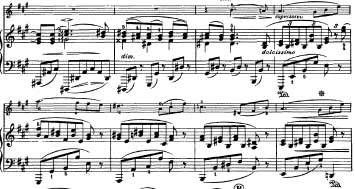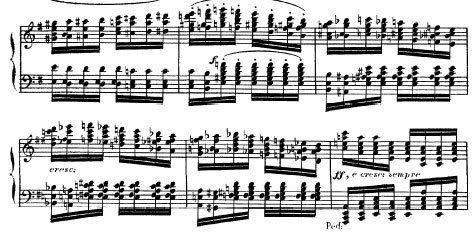|
Chafing Dish
Guest
|
 |
« Reply #30 on: 13:16:26, 09-08-2007 » |
|
Hello Ian, The device you quote from the German Requiem is equally common in Brahms in the reverse direction (I don't know how else to describe it). In your case, an unraised degree is "replaced" by a raised one in another voice. In the following example from op. 100, the reverse happens.  Oof! Sorry about the resolution! In the 6th bar of the example, soprano B# decorates C#, while alto B-natural decorates the tonic. It's a little less striking than the example you cite, i.e., easier to explain theoretically, but more striking in the sense that accidental and natural occur in the same register. All these criteria combine to make false relations into a fascinating topic. One could find a whole list of examples of voice exchanges where one voice travels from 4-5-6 while the other moves from flat6-5-sharp4, including in Bach chorales. |
|
|
|
|
 Logged
Logged
|
|
|
|
|
Ian Pace
|
 |
« Reply #31 on: 13:17:58, 09-08-2007 » |
|
I don't know what a false relation is (apart from someone pretending to be a long-lost uncle) but I suspect it's more than just a clash of semitones. http://en.wikipedia.org/wiki/False_relation |
|
|
|
|
 Logged
Logged
|
'These acts of keeping politics out of music, however, do not prevent musicology from being a political act . . .they assure that every apolitical act assumes a greater political immediacy' - Philip Bohlman, 'Musicology as a Political Act'
|
|
|
|
oliver sudden
|
 |
« Reply #32 on: 13:22:07, 09-08-2007 » |
|
One could find a whole list of examples of voice exchanges where one voice travels from 4-5-6 while the other moves from flat6-5-sharp4, including in Bach chorales.
In Schütz quite often one voice travels 1-7-6-5 while another goes 5-6-7-1. That can be very juicy in the middle of course. In Auf dem Gebirge and Freue dich des Weibes deiner Jugend (very loudly in the cornetts at the cadences!), for example. |
|
|
|
|
 Logged
Logged
|
|
|
|
|
martle
|
 |
« Reply #33 on: 13:23:05, 09-08-2007 » |
|
One of my all-time favourite false relations occurs in Byrd's Ave Verum Corpus. In this recording it occurs at c. 2 mins (and again at c. 2.55). Wonderful scrunch between the F sharp of the D major chord and the F natural of the bass entry (occasioned by the use of the melodic minor scale in this case, Tony). It comes with a 'let's follow along' score, here: http://www.youtube.com/watch?v=KBYLNbKoPP0 |
|
|
|
|
 Logged
Logged
|
Green. Always green.
|
|
|
|
Ian Pace
|
 |
« Reply #34 on: 13:29:34, 09-08-2007 » |
|
Here is what to me is one of the false relations to end all false relations, from the D# minor Prelude from Book 2 of The Well-Tempered Clavier, in bar 20 (there's also one in the join of bars 18 and 19, but less drastic):   Note that the false relation is approached by an interval of a tritone!  (first time I played that at the piano, I was absolutely sure there must be a mistake in the edition or something, or I must have read it wrongly) |
|
|
|
« Last Edit: 13:33:20, 09-08-2007 by Ian Pace »
|
 Logged
Logged
|
'These acts of keeping politics out of music, however, do not prevent musicology from being a political act . . .they assure that every apolitical act assumes a greater political immediacy' - Philip Bohlman, 'Musicology as a Political Act'
|
|
|
|
Chafing Dish
Guest
|
 |
« Reply #35 on: 13:30:22, 09-08-2007 » |
|
One could find a whole list of examples of voice exchanges where one voice travels from 4-5-6 while the other moves from flat6-5-sharp4, including in Bach chorales.
In Schütz quite often one voice travels 1-7-6-5 while another goes 5-6-7-1. That can be very juicy in the middle of course. In Auf dem Gebirge and Freue dich des Weibes deiner Jugend (very loudly in the cornetts at the cadences!), for example. What if it's a major tetrachord on the way up and a Phrygian tetrachord on the way down? Does anyone know examples of that kind? I seem to remember running across one. |
|
|
|
|
 Logged
Logged
|
|
|
|
|
autoharp
|
 |
« Reply #36 on: 14:30:09, 09-08-2007 » |
|
False relations abound in Alkan - a famous and unsubtle example being in the middle section of the Barcarolle op 65 no 6. He delights in harmonic naughties which can however be rationalised horizontally - there's a striking example in the last section of Le festin d'Esope Op 39 no 12 (the last of the studies in minor keys) particular around 21 bars before the end. Sorry, I haven't got a scanner or means to produce the example - would be most grateful if anybody else could oblige . . .
|
|
|
|
|
 Logged
Logged
|
|
|
|
|
Chafing Dish
Guest
|
 |
« Reply #37 on: 14:52:23, 09-08-2007 » |
|
You don't need a scanner for Alkan. Go to IMSLP.org and download the score in question. Use the snapshot tool to select your score passage. Paste into Photoshop or Paint or any similar program Save for Web use (i.e. as a pdf), and post to Photobucket. Then use the code snippet for forums and chatrooms  See? I leave op. 65/6 as an exercise. |
|
|
|
|
 Logged
Logged
|
|
|
|
|
autoharp
|
 |
« Reply #38 on: 14:54:35, 09-08-2007 » |
|
CD - very many thanks for that !
|
|
|
|
|
 Logged
Logged
|
|
|
|
|
MabelJane
|
 |
« Reply #39 on: 15:02:25, 09-08-2007 » |
|
One of my all-time favourite false relations occurs in Byrd's Ave Verum Corpus. In this recording it occurs at c. 2 mins (and again at c. 2.55). Wonderful scrunch between the F sharp of the D major chord and the F natural of the bass entry (occasioned by the use of the melodic minor scale in this case, Tony). It comes with a 'let's follow along' score, here: http://www.youtube.com/watch?v=KBYLNbKoPP0How handy to have the score there too! i expect this sounds wonderful sung live; the clash of the F with the F# must be spine-tingling, but it's not that exciting through my computer here. |
|
|
|
|
 Logged
Logged
|
Merely corroborative detail, intended to give artistic verisimilitude to an otherwise bald and unconvincing narrative.
|
|
|
|
Chafing Dish
Guest
|
 |
« Reply #40 on: 17:10:49, 09-08-2007 » |
|
One of the YouTube comments is "renaissance music is the BEST!" -- is IRF reading this?
|
|
|
|
|
 Logged
Logged
|
|
|
|
|
thompson1780
|
 |
« Reply #41 on: 00:17:49, 11-08-2007 » |
|
Ollie,
Thanks for the Mozart - my computer is too slow to manage the send space thing, but I found a snippet on Amazon which just went up to the piano entry, and covered the bar in question.
All I can say is
WOW!
Cheers
Tommo
|
|
|
|
|
 Logged
Logged
|
Made by Thompson & son, at the Violin & c. the West end of St. Paul's Churchyard, LONDON
|
|
|
|
oliver sudden
|
 |
« Reply #42 on: 00:26:12, 11-08-2007 » |
|
CRUNCH, no?  There's another moment with three adjacent semitones in the A major symphony KV 201... hang on, do I have a score? Ah yes. First movement bar 192, both on the downbeat and on the second beat. A and B sustained in the oboes, A# as an appoggiatura to B in the violins. |
|
|
|
|
 Logged
Logged
|
|
|
|
|
George Garnett
|
 |
« Reply #43 on: 17:08:35, 11-08-2007 » |
|
Blooming 'eck, you have to be bloody quick to hear that one, don't you? My old cloth ears couldn't manage it. (Btw, bar 192 is 15 from the end for those of us whose scores don't have the bar numbers written in and have to count them all  ) It doesn't exactly help that in the recording I've got the oboes get more or less swamped in that bar anyway  But the one in Mozart Piano Cto No 9 that Ollie pointed out earlier is a real naughty squirm with pleasure one  |
|
|
|
« Last Edit: 21:58:33, 12-08-2007 by George Garnett »
|
 Logged
Logged
|
|
|
|
|
oliver sudden
|
 |
« Reply #44 on: 17:22:34, 11-08-2007 » |
|
Blooming 'eck, you have to be bloody quick to hear that one, don't you? My old cloth ears couldn't manage it. (Btw, bar 192 is 15 from the end for those of us whose scores don't have the bar numbers written in and have to count them all  ) But the one in Mozart Piano Cto No 9 that Ollie pointed out earlier is a real naughty squirm with pleasure one  I think even Wolfie enjoyed it: he brings it back twice, once in the major (Bb, A, Ab, bar 33) and then again in the minor in bar 94. And if the soloist plays the longer of the cadenzas Mozart wrote ('cadenza B' chez Bärenreiter) you get the clash again, although without the pedal note. Bar 192 is the last bar of this bit: top line is oboes, treble clef, third line is first violins. (In between are horns in A so don't worry, there isn't a C going on as well...  |
|
|
|
« Last Edit: 17:44:50, 11-08-2007 by oliver sudden »
|
 Logged
Logged
|
|
|
|
|

